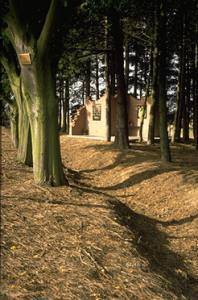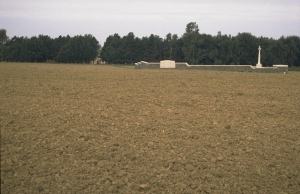
Although Cecil's preference was for a commission with the Royal Engineers - and failing that the Essex Regiment - he was persuaded by the recruiting officer to put himself forward for any infantry regiment in order to avoid delay. On 22nd February 1915 he was duly appointed to the 10th Bn. East Lancashire Regiment with the rank of 2nd Lieutenant. Having spent his £50 allowance on regulation uniform and kit - which to his astonishment still included a sword - Cecil reported to the 10th Battalion at its base in Teignmouth. As a Reserve unit, the battalion's function was to train officers and men in readiness to replace casualties in the front-line battalions of the Regiment. The battalion moved to Swanage towards the end of May and, after much hard work and intense training, was able to send its first draft overseas two months later. In mid-August the battalion moved to new quarters in Wareham, Dorset, where it was to stay throughout the remainder of its existence. It was probably during the summer of 1915 that the family photograph was taken at Eastbrook End. It was not until the spring of 1916 that Cecil - by then a full Lieutenant - received his first posting overseas to France. Neither side had yet been able to break the deadlock on the Western Front. Now the Allies were planning to launch a fresh offensive in the summer of 1916 at the point where the British and French Armies met in the Department of the Somme. Cecil could justifiably have been surprised to find himself posted not to a battalion which had suffered heavy casualties but to one which had yet to face its first major action. On 17th June 1916, together with Lt. Hitchon, 2/Lt. Lett and 2/Lt. Williams1, he reported for duty with the 11th Battalion, the Accrington Pals, at Warnimont Wood between the Somme villages of Bus and Authie. Cecil's first experience of trench warfare would have come just two days later when the battalion took over a stretch of the front line just north of the German-held village of Serre. By the time the battalion was relieved on the night of 23rd/24th June it had suffered casualties from artillery fire of 12 killed and 24 wounded. Back at Warnimont Wood, the Accrington Pals made their final preparations for their rôle in the opening day of the Somme offensive.
As the curtain of fire lifted from the German front line at 7.30am, the Pals advanced across No Man's Land into a hail of machine-gun and artillery fire. Capt. Tough was killed within minutes and, as the shattered remnants of the first wave scrambled through the barbed wire entanglements into the German lines, Cecil may well have been the only officer in the wave still on his feet. In any event, the responsibility would have been short-lived as around this time he was hit just below the right ear lobe by a bullet which flew on through the neck, exiting at the back. As his orderly, Pte. Naylor2, dressed his wounds, he too was hit. For a while the intensity of machine-gun fire over No Man's Land slackened as fighting in the German trenches reached its height. Despite his wound, Cecil was able to work his way back to the British lines where he reported to his Commanding Officer, Lt. Col. Rickman3. Cecil would almost certainly have received treatment from the battalion's Medical Officer, Capt. Roberts, before being sent on to a Casualty Clearing Station behind the lines. The full story of the battle for Serre is told elsewhere.
Within a few days, Cecil was recovering from his wound at 3rd Southern General Hospital in Somerville College, Oxford4.
|


